Sorry I haven’t posted anything in a couple months. I have been working on a talk I will give at the Annual Mining History Conference in Telluride in June. Every time I check a date or other detail, I get sucked into more research, so it has been slow. The topic is the mining interests of William and Eliza’s family, primarily how the boys worked together in various mining ventures.
I will be posting the first draft of my talk which is way too much info for 20 minutes. So I thought you all might like the information. I don’t know how many parts there will be. This is the intro to the family.
Intro to the Patrick Family
I will look at how the brothers and other members of their family worked together in many different mining related ventures from 1875 on through the 1920s. But, I also want to look at each brother separately. While they often combined with one or more brothers in a venture, they also had partners outside the family or just worked alone. They each had distinct mining careers of their own and I think are representative of the “middle” miner, the owner/manager/engineer/investor of their time.
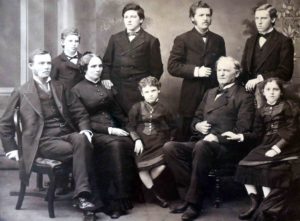
This is the family of William and Eliza Patrick of St. Louis around 1875. Of the nine people in this picture, only Henri Mae ( the girl in the middle) had no dealings with mining. She married a doctor from Philadelphia and I haven’t been able to find any indication that she or her husband ever invested in any of the mining interests of her family.
William was a successful lumber merchant. He was from Birmingham, PA, now the south side of Pittsburgh. His father had been a stone mason from Ireland who went bankrupt when he was 13. William had to leave school and go to work, first as a cabin boy on steam boats and later was able to obtain an office job where he learned about business.
In 1840, William and his elder brother, James, started working together by shipping coal to the Gas Works in St. Louis. By 1847, they had changed to lumber and William moved to St. Louis to take charge of that end of the business. Over the next 30 years the two brothers formed several lumber businesses together and separately with other partners, a pattern his sons were to follow.
Eliza was born in Ohio and educated at the Washington Female Seminary. Female Seminaries taught young ladies Greek, Latin, French, German, Geography, Chemistry, Biology, Mathematics, and many seminaries developed into women’s colleges later in the 19th century. So Eliza was better educated than William. In St. Louis, Eliza was active in the women’s suffrage movement. She was a founding member and second Vice-President of the Woman Suffrage Association of Missouri.
The last business venture that William and his brother James shared was the Knoxville Marble Company. On March 13, 1873, the Knoxville Daily Chronicle had a small announcement about the company.
When the government building is completed, a private company will take charge of the quarry and proposed to get out marble for shipment to some of the large cities. The company is composed of George W. Ross, of this city, and Gen. J. H. Holman, and J. and W. Patrick, of St. Louis. The last two are very wealthy, controlling millions of capital.
I like the sound of “millions of capital” but the reality was probably, at most, one or two hundred thousand dollars apiece. James sold his interest by 1878, but William continued as president of the company until 1886 or so.
I don’t know much more than this because no mention of the Knoxville Marble Company has ever been made in family records. I just stumbled upon it last January. I include it because I love the thought of my family having had millions of dollars, it explains how my great-grandparents met, and it happened when my great-grandfather, William Francis was studying mining engineering at Washington University in St. Louis. He was probably able to get some practical experience at the quarry.
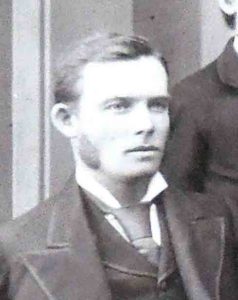
James M. Patrick (1848 – 1918) was the oldest surviving child. He attended Washington University, but didn’t graduate. He worked for his father both in the lumber businesses and as a teller when his father was St. Louis City Treasurer.
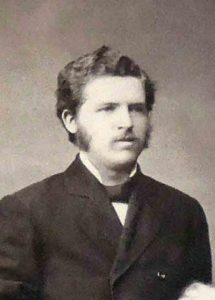
William Francis Patrick (1852 – 1905) is my great-grandfather. He got his bachelor’s degree in 1872 from Washington University and his mining engineering degree in 1874. He then joined the Newton-Jenney Expedition to the Black Hills as an assayer. He stayed in the Black Hills a little while to do some prospecting, but ended up in Georgetown, Colorado by early 1876.
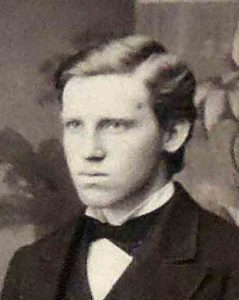
Warner K. Patrick (1858 – 1914) was the quiet one in the family. He also took some classes at Washington University, but didn’t graduate. His specialty was woodworking.
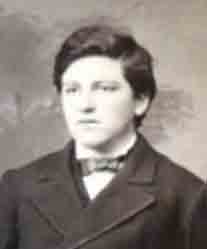
Edward T. Patrick (1861 – 1924) was the family lawyer. He graduated from the St. Louis Law School at Washington University in 1884. He practiced in St. Louis then moved to Chicago for several years before finally following the rest of the family to Colorado in 1890.
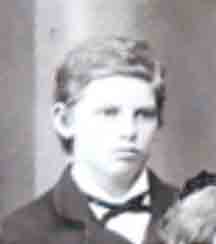
Lucien L. Patrick (1863 – 1944) was the youngest brother. He attended the Manual Training School at Wash. U. He got into trouble, a lot. A family story is that was once whipped for interrupting Susan B. Anthony when she was addressing a small gathering at the Patrick home.

And then finally, we come to Clara. The May Institute was the female seminary part of Washington University. She married William H. Eddy, a friend of Edward’s in Chicago, in 1888. He was a first cousin of John Cleveland Osgood of CF&I. But they don’t seem to have had any contact in Colorado.
The Patrick Family lived across the street from the original location of Washington University, so it was easy for them to attend. Even Eliza took courses in the Fine Arts Department.
